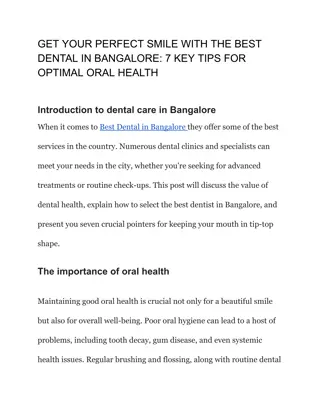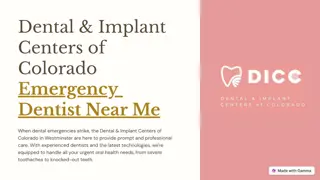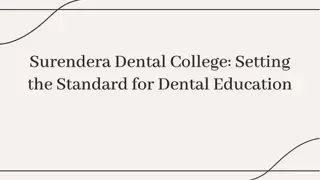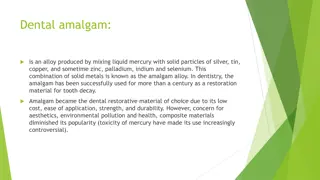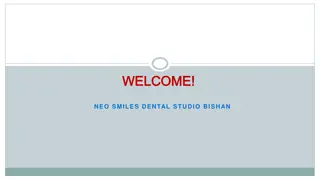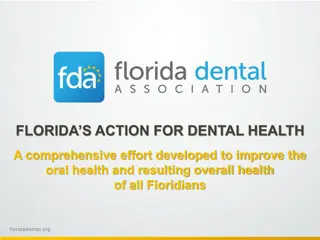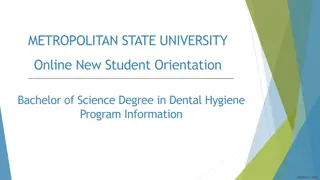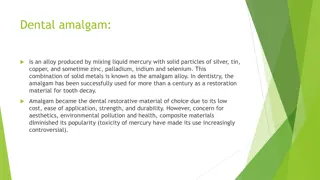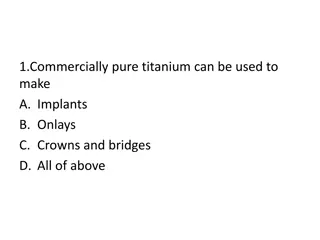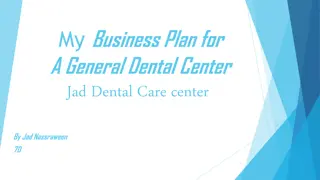Dental Amalgam Control Program Overview and Best Practices
The Metro Wastewater Reclamation District has implemented a Dental Amalgam Control Program to regulate all dental facilities within its service area. This program covers Best Management Practices (BMPs), Amalgam Separator Installation, Operations and Maintenance (O&M) requirements, Record Keeping, and Annual Inspections. The EPA approved changes to the District's Rules and Regulations to include this program, with anticipated nationwide application. BMPs focus on preventing mercury and metal disposal through specific measures like using precapsulated amalgam, proper equipment maintenance, and recycling practices.
Download Presentation

Please find below an Image/Link to download the presentation.
The content on the website is provided AS IS for your information and personal use only. It may not be sold, licensed, or shared on other websites without obtaining consent from the author. Download presentation by click this link. If you encounter any issues during the download, it is possible that the publisher has removed the file from their server.
E N D
Presentation Transcript
Metro Wastewater Reclamation District Dental Amalgam Control Program Implementation & Training Slide 1
Outline Dental Amalgam Control Program Overview Best Management Practices (BMPs) Amalgam Separator Installation & Certification Operations and Maintenance (O&M) Plan Record Keeping Requirements Annual Requirements and Inspections Slide 2
Dental Amalgam Control Program Overview Slide 3
Dental Amalgam Control Program Overview On August 19, 2014, the EPA approved changes to the Metro District s Rules and Regulations to add a Dental Amalgam Control Program to regulate all dental facilities within the Metro District s service area. In the summer of 2016, the EPA s Proposed Dental Effluent Guidelines are expected to be finalized. This ruling may supplement the Metro District s existing Dental Amalgam Control Program, as this ruling will apply to all existing programs and dental facilities across the nation. Dental Amalgam Control Program Overview Slide 4
Dental Amalgam Control Program Overview (Continued) The Metro District s Dental Amalgam Control Program Advisor must be posted in a prominent location! Dental Amalgam Control Program Overview Slide 5
Best Management Practices (BMPs) Metro District Rules and Regulations 6.16 Slide 6
Best Management Practices (BMPs) Best Management Practices (BMPs) are control measures required of the dental facility to prevent or control the disposal of mercury and other metals in the form of restorative amalgams. Use precapsulated, single-use amalgam. Bulk mercury must not be used, and any remaining bulk mercury must be appropriately recycled. All dental chairs must be equipped with chair-side traps, and all vacuum pumps equipped with traps or filters. All equipment shall be cleaned and maintained in accordance with the manufacturer s instructions. Disposable chair-side traps should be placed in a scrap amalgam collection container, and the contents of re-usable chair-side traps should be emptied in a scrap amalgam collection container for recycling. Best Management Practices (BMPs) Slide 7
Best Management Practices (BMPs) (Continued) Do not rinse screens, filters, traps, amalgam separators or any other amalgam-containing equipment over sinks or drains. In the event that amalgam is spilled, proper cleaning and disposal procedures must be used. A mercury spill kit can be utilized for such occurrences. Spilled amalgam must be cleaned up immediately. Each dental facility must provide protection from accidental discharges. Dental staff should be trained in the proper handling and disposal of amalgam material and maintain a log documenting such training. (Example Staff Training Log on next slide.) Best Management Practices (BMPs) Slide 8
Best Management Practices (BMPs) Example Staff Training Log (Handling and disposal of amalgam material) Training Detail Training Date Employee Name Employee Signature Dr. Jones demonstrated proper handling of new amalgam separator and showed how to remove and replace full amalgam separator cartridges. 03/15/15 Jane Doe _________________ 03/15/15 John Doe _________________ 03/22/15 Pat Smith _________________ Demonstration of chair-side trap maintenance by Jane Doe 04/10/15 John Doe _________________ 04/10/15 Pat Smith _________________ Best Management Practices (BMPs) Slide 9
Best Management Practices (BMPs) (Continued) All contact and non-contact amalgam scrap must be salvaged and stored in structurally sound, tightly closed and appropriately labeled containers. Recycle ALL amalgam waste by transferring waste to an offsite recycling facility for recycling of mercury or manage and dispose of the waste in accordance with applicable federal, state and local hazardous waste laws and regulations. At no time should amalgam waste be disposed of or flushed down the drain or toilet! Best Management Practices (BMPs) Slide 10
Best Management Practices (BMPs) (Continued) Only use non-chlorine, non-oxidizing disinfectants and neutral cleaners. Chlorinated, oxidizing cleaners will cause mercury to dissolve and pass through the amalgam separator system. Examples of non-chlorine, non-oxidizing disinfectants Slide 11
Best Management Practices (BMPs) (Continued) All dental facilities must certify annually (by December 31), that all BMPs were followed. All certifications must be signed by an authorized representative of the dental facility. Best Management Practices (BMPs) Slide 12
Quiz #1 Slide 13
Quiz #1 All contact and non-contact amalgam scrap must be salvaged and stored in: Brown paper bags. 1. a) Structurally sound, tightly closed and appropriately labeled containers. b) Fish bowls. c) All amalgam waste should be disposed of by: Transferring waste to an off-site mercury recycling facility. 2. a) Disposing of the waste in accordance with applicable federal, state and local hazardous waste laws and regulations. b) All of the above. c) It is okay to flush amalgam waste down the drain or toilet: True 3. a) False b) Quiz #1 Slide 14
Quiz #1 (Continued) How often should BMP Certifications be submitted to the Metro District? Monthly 4. a) Annually b) Quarterly c) What should your office do with the Dental Amalgam Control Program Advisor? Post it in a prominent location 5. a) Throw it away b) Mail it back to the Metro District c) Dental facilities should only use the following types of cleaners: Only bleach and chlorine. 6. a) Non-chlorine or non-oxidizing disinfectants and neutral cleaners. b) None A little dirt never hurt anyone. c) Quiz #1 Slide 15
Quiz #1 (Continued) All dental chairs must be equipped with chair-side traps, and all vacuum pumps equipped with traps or filters. This equipment must be cleaned and maintained: 7. In accordance with the manufacturer s instructions. a) By staff properly trained to handle disposal of amalgam material. b) All of the above. c) Quiz #1 Slide 16
Amalgam Separator Installation & Certification Metro District Rules and Regulations 6.16.1(2)(a)(b)(c) Slide 17
Amalgam Separator Installation & Certification All amalgam-containing wastewater must be discharged through an amalgam separator. Amalgam separators must comply with ISO 11143 standards, or equivalent, and designed with a minimum removal of 98% solids, unless otherwise approved by the Metro District. Amalgam separators must be properly sized for the volume and flow of the dental facility s amalgam wastewater in accordance with the manufacturer s specifications and recommendations. Amalgam Separator Installation & Certification Slide 18
Amalgam Separator Installation & Certification (Continued) Amalgam separators must be installed, operated and maintained according to the manufacturer s specifications. A certification statement must be submitted to the Metro District within 30 days of the installation or replacement of an amalgam separator. Thereafter, compliance certifications must be submitted annually certifying the separator has been properly used and maintained. All certifications must be signed by an authorized representative of the dental facility. Amalgam Separator Installation & Certification Slide 19
Operations and Maintenance Plan Metro District Rules and Regulations 6.16.1(3) Slide 20
Operations and Maintenance Plan An Operations & Maintenance (O&M) plan is a program used by dental facilities to ensure proper operation and maintenance of all amalgam separators and documentation of maintenance activities. Required maintenance according to the manufacturer s recommendations must be performed and documented. Collection devices must be replaced per manufacturer s recommendation or when solids reach the full line; whichever comes first. Amalgam wastes should be transferred to an offsite mercury recycling facility or managed and disposed of in accordance with applicable federal, state and local hazardous waste laws and regulations. A monthly visual inspection of the amalgam separator(s) must be performed, and an inspection log must be kept with dates and personnel signatures. This applies to all separator models, regardless if the collection canister is clear or opaque. (See Example Inspection Log on next slide.) Operations and Maintenance Plan Slide 21
Operations and Maintenance Plan Example Inspection Log (Monthly Visual Inspection of Amalgam Separator(s)) Inspection Date Employee Name Employee Signature Inspection Notes Sludge level below full line. 10/01/15 Jane Doe _______________________ Sludge level approaching full line Ordered new cartridge today. Cartridge replaced today. 11/01/15 John Doe _______________________ 12/01/15 Pat Smith _______________________ Operations & Maintenance Plan Slide 22
Record Keeping Requirements Metro District Rules and Regulations 6.16.1(5) Slide 23
Record Keeping Requirements The following documentation must be established and maintained for no less than three (3) years and made available for review upon request from the Metro District. Receipts or documentation from recycling or disposal facility of all recycling and disposal shipments of amalgam waste; Logs of amalgam waste removed for the vacuum system or plumbing; Documentation of maintenance performed on any amalgam separator; and Employee training logs. (See Example Amalgam Removal Log on next slide.) Record Keeping Requirements Slide 24
Operations & Maintenance Plan Example Amalgam Removal Log (For amalgam waste removed from the vacuum system or plumbing, amalgam separator maintenance, or other documentation from recycling or disposal facility of amalgam waste recycling and disposal shipments.) Event Date Event Type Employee Name & Signature Off-Site Vendor Notes Full amalgam separator cartridge returned. Mercury Recycling Company XYZ Amalgam separator cartridge full. Replaced with new cartridge & sent full cartridge to Mercury Recycling Company XYZ for recycling. See waste manifest / recycling receipt. 03/15/15 Jane Doe ______________ Scrap recycling bucket full. Mercury Recycling Company ABC Secured scrap amalgam bucket and mailed to Mercury Recycling Company ABC - See shipping invoice. 06/22/15 John Doe ______________ Wet vacuum filter cleaned. Filter waste emptied into scrap amalgam bucket. 08/30/15 Pat Smith ______________ N/A Chair-side traps replaced. Disposable chair-side traps placed in scrap amalgam bucket and replaced with new traps. 11/03/15 Jane Doe ______________ N/A Record Keeping Requirements Slide 25
Annual Requirements and Inspections Metro District Rules and Regulations 6.25 Slide 26
Annual Requirements and Inspections Right of Entry The Metro District may conduct inspections of the facility and examine and copy any records required to be maintained by this facility to determine compliance with the conditions of our Rules and Regulations. Inspections Metro District staff may perform an inspection at your facility to verify compliance with the Metro District s Dental Amalgam Control Program. Inspection components include: Amalgam separator(s) and related plumbing, as well as chair-side traps and vacuum pumps. Implementation of Best Management Practices. Verify type of amalgam used. Bulk mercury must not be used. Spill prevention and control procedure to protect from accidental discharge. Maintenance records and waste manifests. Annual Requirements and Inspections Slide 27
Annual Requirements and Inspections (Continued) Inspections (Continued) Employee training logs. Program Advisor posted in a prominent location in the office. Use of only non-chlorine or non-oxidizing (neutral) cleaners. Any other processes with discharge to the sanitary sewer. Noncompliance Noncompliance with the conditions of the Metro District s Rules and Regulations may subject the facility to enforcement action as deemed appropriate by the Metro District. Looking Forward In accordance with the Metro District s Rules and Regulations, dental facilities will be required to certify BMPs, Amalgam separators and O&M plans annually. Additionally, facilities can expect to be occasionally inspected to verify paperwork, certifications and overall compliance. Annual Requirements and Inspections Slide 28
Quiz #2 Slide 29
Quiz #2 Amalgam separators must comply with ISO 11143 standards and be designed with a minimum removal of: 98% Solids 1. a) 85% Solids b) 50% Solids c) Amalgam separator compliance certifications that the separator has been properly used and maintained must be submitted: Monthly 2. a) Never b) Annually c) Amalgam separators must be installed, operated, maintained and properly sized for the volume and flow of the dental facility s amalgam wastewater according to: The government. 3. a) The manufacturer s specifications and recommendations. b) The ADA c) Quiz #2 Slide 30
Quiz #2 (Continued) An O&M plan requires the following monthly procedure: Visual inspection of the amalgam separator(s). 4. a) Inspection log updated with date and personnel signature. b) All of the above. c) Collection devices must be replaced: Per the manufacturer s recommendation. 5. a) When the solids reach the full line. b) All of the above. c) Documentation must be established and maintained for no less than three (3) years for the following: Recycling or disposal facility receipts or documentation. 6. a) Logs of amalgam waste removed from the vacuum system or plumbing. b) Documentation of maintenance performed on any amalgam separator. c) Employee training logs. d) All of the above. e) Quiz #2 Slide 31
Thank You! CONTACT INFORMATION: SCOTT CALDWELL SUZANNE RENTER AMALGAM CONTROL PROGRAM INVESTIGATOR PHONE: 303-286-3182 SCALDWELL@MWRD.DST.CO.US AMALGAM CONTROL PROGRAM INVESTIGATOR PHONE: 303-286-3128 SRENTER@MWRD.DST.CO.US LORI MAAG INDUSTRIAL WASTE SUPERVISOR PHONE: 303-286-3434 LMAAG@MWRD.DST.CO.US http://sd.keepcalm-o-matic.co.uk/i/the-end-thank-you-for-watching-2.png Slide 32












